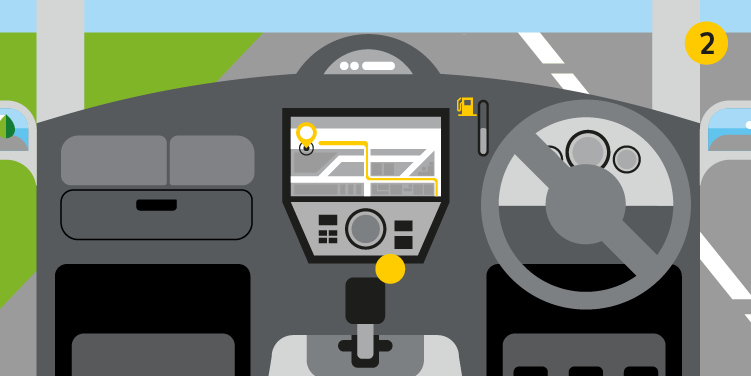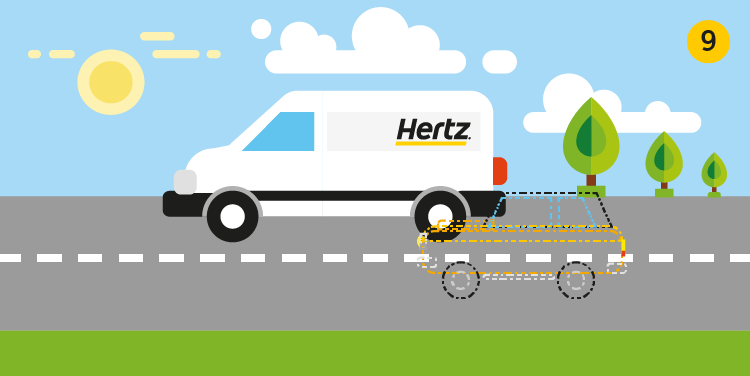
10 TOP TIPS FOR DRIVING A VAN
The thought of driving a van for the first time can be quite unnerving - but trust us, it’s actually a lot easier than you may think.
Most modern vans are just like regular road cars, right down to features like ABS brakes, stability control systems, steering-wheel airbags and sound systems. Still, it certainly pays to be prepared.
That’s why we’ve put together 10 top tips for driving a van – so you can drive the band to the gig/finally get round to clearing out the attic/hit the road with complete confidence!

1. Know how you’re getting from A – B!
Planning and preparation is key when it comes to driving a van for the first time. Before you set off, make sure you have your route – and an alternative route - mapped out on the sat-nav. Driving along unknown roads or getting lost can send your stress levels through the roof and in turn impact on your safety – so make sure you know how you’re getting from A to B!

2. Getting in gear
It’s also sensible to spend some time getting used to the controls and your gearbox before setting off, as most vans have six gears as opposed to the standard five gear system in most cars. The extra gear is nothing to worry about – but should be used if you’re driving on the motorways to save fuel.

3. Watch your speed!
When driving, always scan the road ahead for hazards and obstacles and adjust your driving to suit. Remember it’s not a race – so make sure to carry less speed and leave more space for braking than you would in a conventional car.

4. Watch out for the roof!
While you don’t need to worry about height for the first three rungs up the Hertz van hire ladder - as they’re comparable in size to conventional cars - the largest vans may be too tall for the very lowest bridges and other overhanging obstacles.
Take care therefore when entering car parks and multi-storey car parks! You don’t want to take the roof off…

5. Take care when turning corners
Width can also be an issue for the larger van classes.
It sounds obvious, but the bigger the van, the more space you need to leave as you enter a corner or make a turn around an obstacle. Remember, there’s more vehicle behind you that you’re used to! Again, it’s all about forward observation. If in doubt, slow or come to a complete stop to assess any obstacles.

6. Consider the weather!
It’s important to consider weather conditions when driving a van. For the most part, vans perform as well as cars in poor weather, with the previous provisos regarding lower speed and leaving larger margins. But very high winds can be dangerous when driving a van – especially if you’re driving an empty van.
The best advice for driving in windy weather is to slow down slightly, keep your eyes on the road and try to keep a safe distance from high-sided buses or trucks.

7. Fully loaded van? Watch your speed!
You also need to be aware of the difference between driving an empty and fully loaded van.
For starters, the large storage bay and carrying capacity means a van can accommodate very heavy loads. That makes a significant difference to all aspects of performance from acceleration to braking and handling.
In short, err on the side of caution and leave even greater margins to other road vehicles, watch your speed and allow more space for braking when driving fully loaded.

8. To me – to you! Load the van securely and evenly
An overloaded or poorly loaded van can be dangerous. So take note of the van’s maximum load capacity and make sure that all items and materials are loaded securely, spread evenly and as low as possible in the bay to ensure both safety and to minimise damage.
Loose materials can be a serious hazard - and the higher up items are stored, the more likely they are to cause stability problems as well as breaking lose and becoming damaged.

9. It’s behind you! Be aware of blind spots
Rearward visibility is another major difference between vans and cars. Hertz’s smallest van group, is very similar to a car in this regard aside for the rear-quarter or the over-the-shoulder view, where a steel panel replaces the rear side windows. As a consequence, be aware of the blind spots over both shoulders created when merging into lanes.
The larger vans on the Hertz fleet have the same rear-quarter blind spots but also more limited direct reward visibility thanks to the omission of the centre rear-view mirror. Instead, you must rely upon a pair of extra-large wing mirrors. Just remember that the larger a van is, the more likely it is that cars and other small vehicles following closely behind may be partially or entirely obscured.

10. Take a mate – they’ll be handy when you need to park!
There can be challenges when it comes to parking a van. Again, the larger the van, the more adjustments you’ll need to make compared to parking a standard car. The smaller groups are just like parking a car. The larger models require more care.
Having a co-driver on hand helps significantly, as they can disembark the van and help guide you safely into parking slots. If you’re travelling solo, simply take it step by step. A good method where traffic conditions allow is to stop the van completely, get out and assess the space fully.
You’ll then be able to make better sense of both the space available and what you can see in the wing mirrors. If in doubt, you can always stop, exit the vehicle and reassess the situation, again taking care of traffic conditions. Also, if the location is busy, don’t allow other vehicles to pressure you into rushing. Take your time and don’t feel embarrassed to abort and retry if you aren’t confident the van is lining up correctly. Better to suffer a few toots from impatient road users than hitting the van!